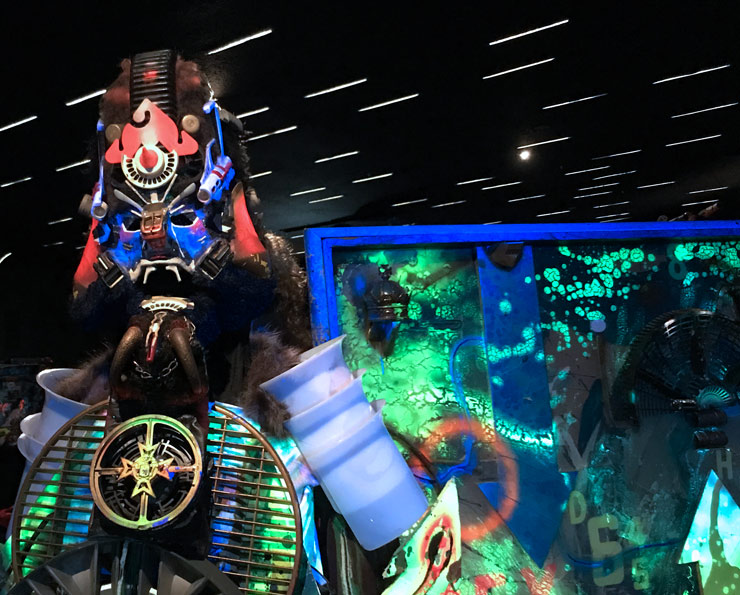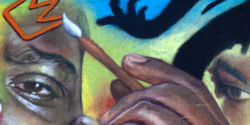Intergalactic Godhead and one of New York’s lost sons, the multidimensional Rammellzee is here, at least his pyramidic urn is. The train writer, performance artist, plastic artist, language master, mathematics interpolator, hip-hop pioneer and one of the original “Wild Style” and “Style Wars” alumni brings the big guns to Red Bull Arts.
Rammellzee. Detail. (photo © Jaime Rojo)
Rewarded the instant you enter, the flying intergalactic battleships greet you at the door, leading you into the blissful blacklit abyss below, provoking a humorous inner sense of a warring gothic future. But first you can explore the brighter white-box gallery above with a small theater behind for video and various listening stations, photography, augmented with vitrines of emphemera and original texts from the audacious imagineer.
The largest survey of its kind of work by the artist, who passed away in 2010, this is a considered collection of images, writings, sculpture and costume that give you the idea that it only approximates the vast galaxy of histories and characters that the iconoklast panzerist stored in his imagination.
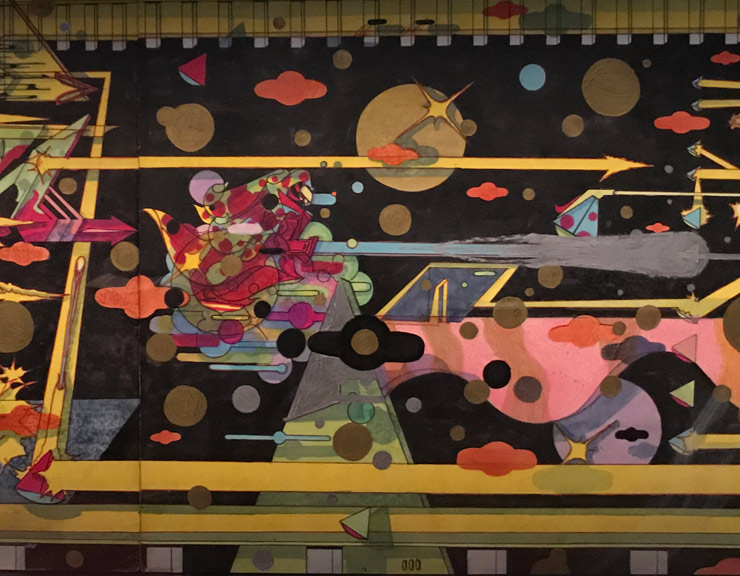
Rammellzee. “Evolution Of The World 1979” Detail. (photo © Jaime Rojo)
“These costumes remind me of George Clinton,” says experimental filmmaker and writer Tessa Hughes-Freeland maker and writer at the opening Thursday night for “Racing for Thunder”. She was one of many New York royalty from the “Downtown” and graffiti scenes of 80s-90s New York who were attending the flooded opening this week, including artists like Lee Quinones, Futura, Torrick Ablack aka Toxic, and John Fekner.
“I don’t remember him wearing all of these costumes,” says painter Jane Dickson as she looks at the mythical deities glowing and raging in the smoky haze.
“Actually I do remember him in that one at an event,” she says motioning to an intimidating fluorescent grill-faced figure in a stylize kimono. Her husband Charlie Ahearn, who directed Rammellzee in Style Wars, was interested in creating a movie solely about the artists many characters and his fully immersive commitment to the environments he built in his loft in the 80s and 90s.
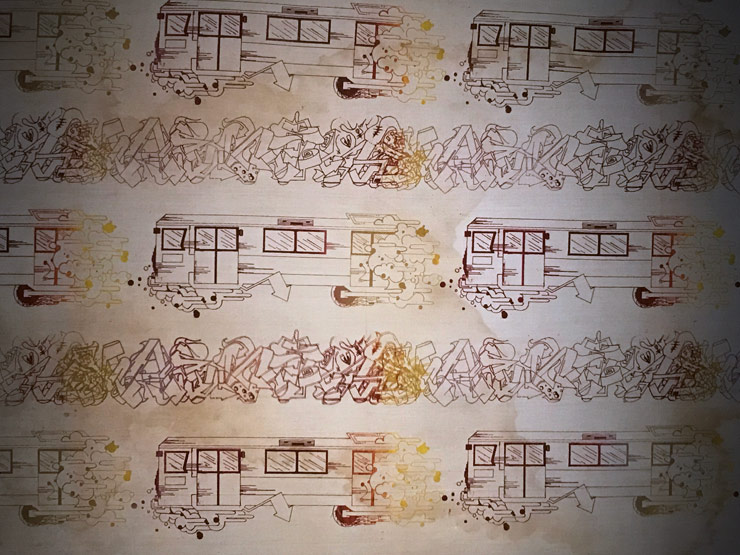
Rammellzee. “Maestro 1979“. Detail. (photo © Jaime Rojo)
The crowd coursing through the exhibit listens to recordings, watches raw video, drinks champagne, and wishes for decoder rings in the vain hope of peering into the mind of this child of the Rockaways who painted the A train and recorded music that influenced musicians as diverse as the Beastie Boys and Big Audio Dynamite, who dedicated a song to him.
The extensive collection, much of it never before seen, took more than a year to assemble and curate for Chief Curator Max Wolf and cultural critic Carlo McCormick, who created the exhibition with Associate Curators Christian Omodeo, Jeff Mao, and Candice Strongwater.
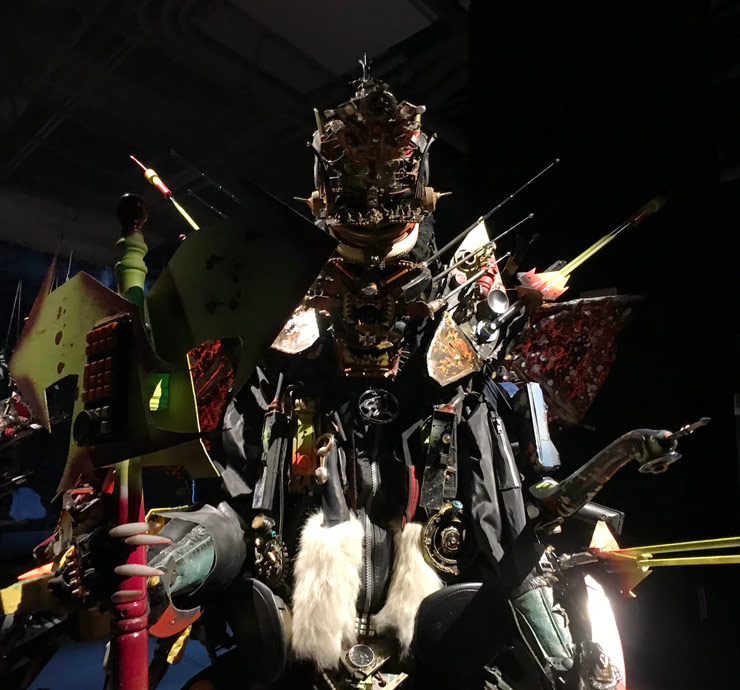
Rammellzee. Detail. (photo © Jaime Rojo)
We captured a few details from the show during installation which we show here to whet your appetite and spoke with McCormick, who also knew the artist personally and took decisions about the exhibit with a precise appreciation for Rammellzee’s place in the canon of graffiti, post-graffiti, hip-hop, mathematics, and performance.
BSA: Part of Rammellzee’s story lies in the environments that he created to share with artists and friends – and to use as a laboratory. How can an exhibition achieve some of that same unique atmosphere?
Carlo McCormick: The most tempting thing to do as a curator was to re-create “The Battle Station”, which was his home studio, and it was kind of a “life’s work” installation that way. But it just seemed that this was also Max Wolf’s project as well, who co-curated it, and it is also a focus to make these things be engaged and discreet.
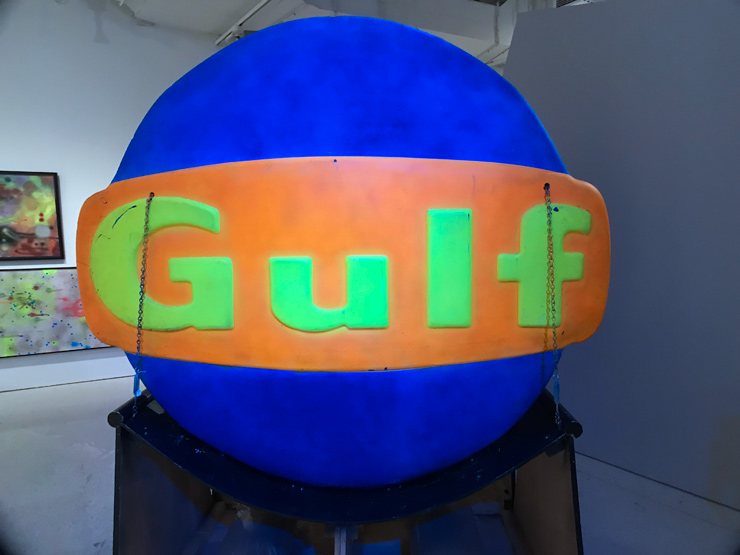
Rammellzee. Detail. (photo © Jaime Rojo)
You’ve got the whole thing: the Garbage Gods, Gassolear, and the Letter Racers. It’s kind of like his final showdown of good versus evil. But we wanted to allow it to be in a fine art space so you could register as much of “the gaze” as you could looking at any other art.
It’s still black light illuminated; Rammellzee liked to paint all of his walls black. I know he did it at Barbara Braathen and Fashion Moda. One time he did this at this one gallery – the gallery owner left him the keys to the gallery to prepare the space. She came back the next day and really what he had done was he had painted all the walls black. She’s was like, “What?”
So we didn’t do that, we tried to give it a little bit of the privilege of the white space because now he is dead and it is better to be in conversation with that whole history with Western art.
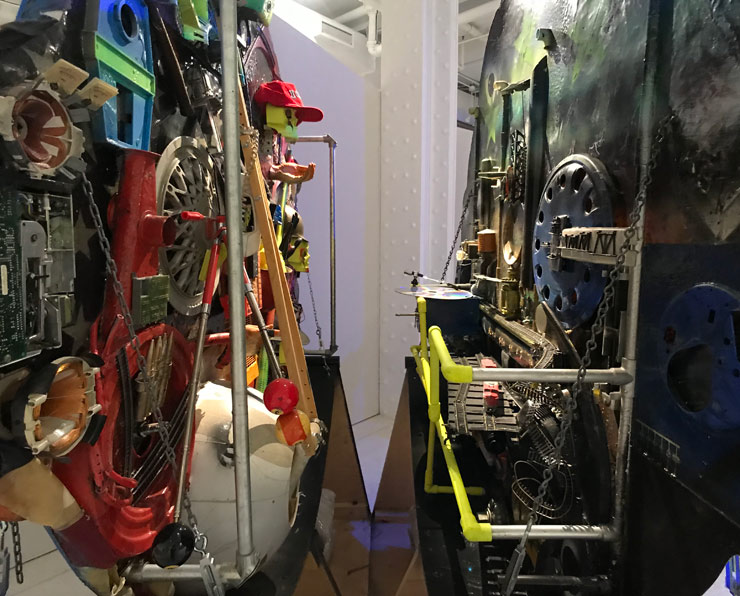
Rammellzee. Detail. (photo © Jaime Rojo)
BSA: Can you talk about going through the artwork and costumes that Rammellzzee and Carmela had stored away? What kind of thoughts and feelings were you experiencing?
Carlo McCormick: Everything looked kind of squalid when it had just been pulled out of storage and from this other storage facility that Sotheby’s had.
It was sort of underwhelming because he was sort of working with bits of garbage and rags. And the costumes are really fly fashion but it’s really made on the cheap – its like “costume” instead of “clothing” right? It was all scattered about.
And there was someone who went all of the old performance photos and basically re-assembled all of these personalities – because they were not stored in a bag separated for each character. There were just racks of costumes and boxes of masks and things like that.
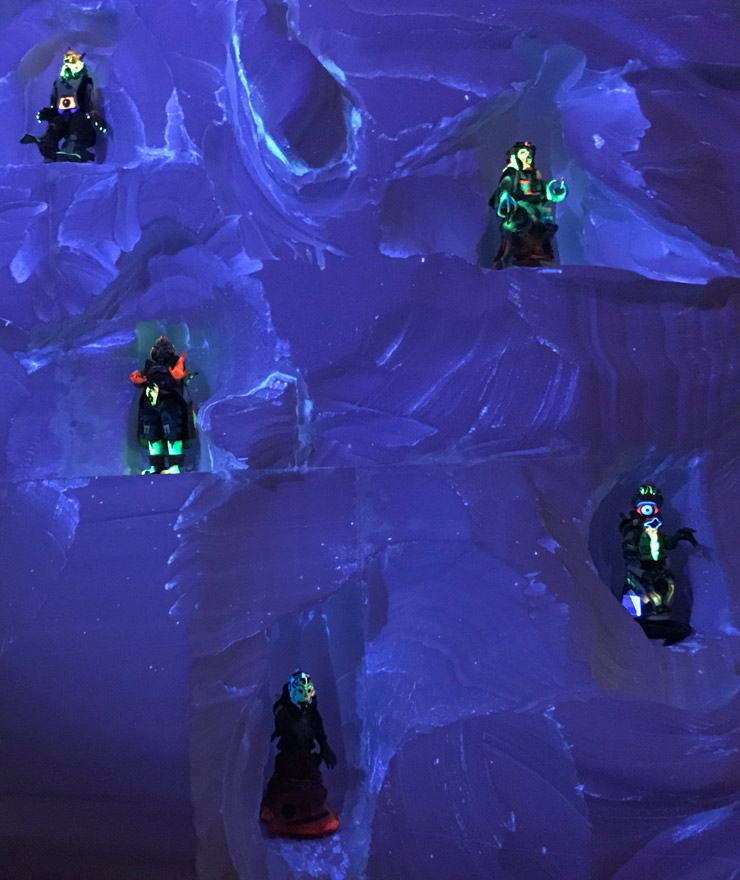
Rammellzee. Detail. (photo © Jaime Rojo)
They had to put all of these elements together – so that was really amazing. But once it is all put together it is so much more magical. That’s kind of the way he collaged everything – he had an amazing ability to put things together.
This is just the first show so it has that honor but it is a dubious one because it is just a start and now there is the hope that more scholarship and more curatorial work and more work all around can go into Rammellzee’s estate and his legacy.
Considering that this was all done in a year with a pretty small team here at Red Bull, its amazing the amount of resources they pulled. How cool it is to think, “There is no way we can go through all of the ephemera” and then to be able to say, “Hey get Christian Omodeo in here to do the archives for this.” So it has been a really cool thing to make all of this happen because they allow you to entertain pretty elaborate schemes.

Rammellzee. Treatise On The Luxturnomere. (photo © Jaime Rojo)
BSA: Was he thinking in terms of posterity and about having a great show in the future. Did he care?
Carlo McCormick: I think, like a lot of people at that time, he had a really ambivalent relationship to ‘the market’ and ‘the art world’ and the gallery system and all that stuff for a moment there. He was very ambitious and he saw how friends of his were beginning to paint and people were paying attention and he goes, “Shit I can do that”.
So I think he didn’t always like the art world. I think he kind of really hated it in some ways but he attached himself to it for 10 years with the paintings and continued a collector base through his death in 2010. I’m sure, in his mind, he never would be forgotten. He was so important.
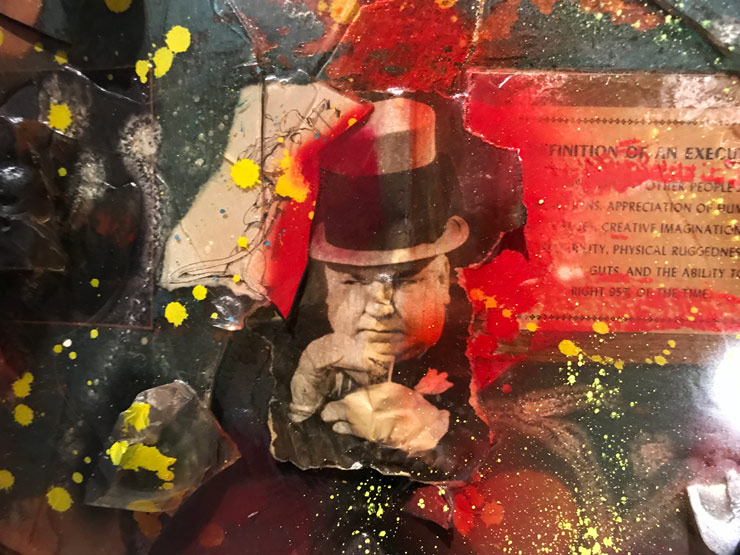
Rammellzee. Detail. (photo © Jaime Rojo)
BSA: The artist had such a unique fantasy world in his imagination with galactic battles and love of the letters and projections into the future. Would you say he was acting as a character – or maybe that he became that character?
Carlo McCormick: He was many characters. I think that one of the things that people are going to start paying more attention to outside of the obvious place in Hip-Hop and in graffiti art and what was going on in 1980s painting is the performance work. In that he is adopting so many fluid identities.
Also, as we were noting before when we were walking through it, he was crossing gender and doing a lot of things that are not typical for the work of that vernacular. He was doing a lot of it. With identity politics and performances now I think that a lot of people are going to look at that work with a different eye.
BSA: What influenced his mind? Why did he do what he did?
Carlo McCormick: That’s the basic thing you know. When you read that first treatise – and he kept on doing these manifesto type things – even from the first one at this really early age, he was an incredible autodidact, all self-taught. There was just massive amounts of information of all sorts of theory and math and science and military. I mean it’s all over.
He’s an autodidactic and a polymath. So I don’t really know where all of it came from. Sometimes you just have to think “maybe he watched a lot of Transformers on TV!” Who knows.
BSA: Many people will be learning about this multi-dimensional artist for the first time. What do you want them to know about him and his brilliance?
Carlo McCormick: I really hope the work can speak for itself. He was as conceptual as he was urban. I hate to poison the well. He is so open to so many readings. He is being grabbed now by other forces that are in the market and those are being brought to bear.
So for me one of the things here was to bring this from out of the community and from all of the artists he worked with and was friends with. One of the things was I didn’t want to be the only person speaking for Ram when there were all of these other people still around.
I would say “Come in with and open mind and expect it to be blown.”
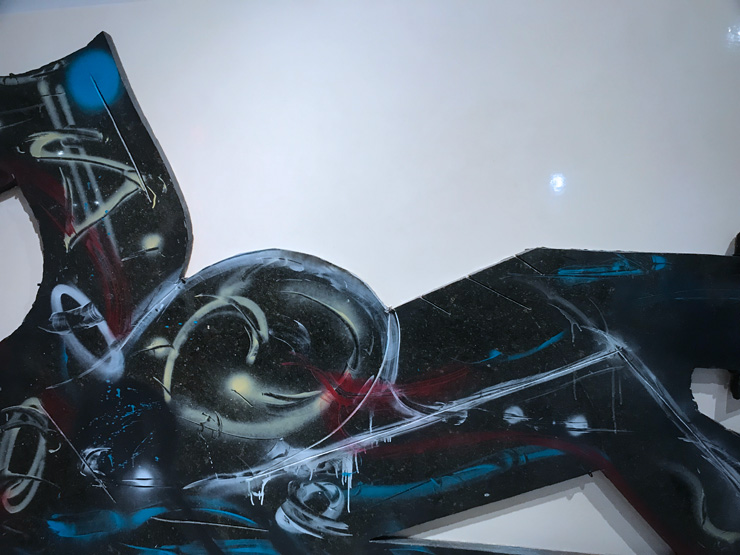
Rammellzee. Detail. (photo © Jaime Rojo)
RAMMΣLLZΣΣ: Racing for Thunder is organized by Max Wolf and Carlo McCormick, with Candice Strongwater, Jeff Mao, and Christian Omodeo.
RAMMΣLLZΣΣ: Racing for Thunder is now open to the general public. Click HERE for more details.
Other Articles You May Like from BSA:
When you hear the name of Street Artist Don’t Fret you can be assured that he means exactly the opposite. Exposing random and selected people’s faults, foibles, and fraternizing habits is just a way t...
Our weekly focus on the moving image and art in the streets. And other oddities. Now screening : 1. "Circle of Abstract Ritual" Jeff Frost 2. Blek le Rat in NYC via Complex 3. Narcelio Grud: F...
Geologist, public artist, visual artist, earth activist, political activist, anthropologist, researcher, costume designer, environmental engineer PhD. Andrecco is all of these. Add performance artist ...
Since the early 70s Lonely Planet publishing has made guidebooks for travelers of the world, enabling people to gain a greater understanding and to appreciate localities, cultures, and histories. Ed B...
Not quite spring, the Art Fairs are arriving in New York ahead of the tulips. We strolled the impossibly long aisles and peered into the booths to find the folks who have at other times been called ...
 BROOKLYN STREET ART LOVES YOU MORE EVERY DAY
BROOKLYN STREET ART LOVES YOU MORE EVERY DAY